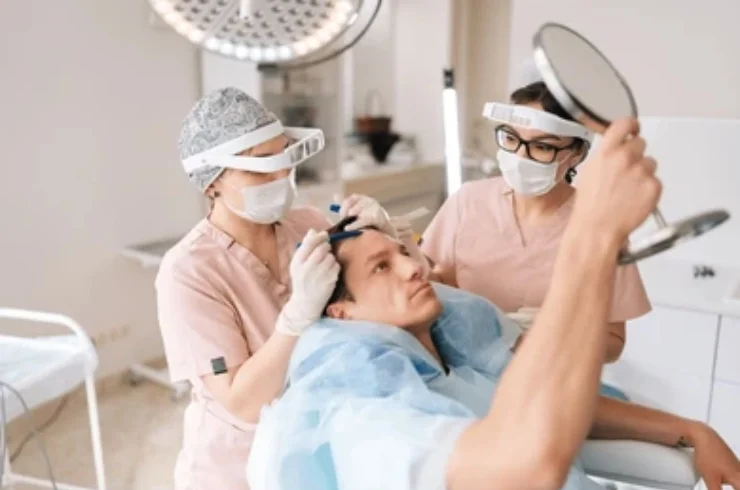Who is a Good Candidate for Hair Transplantation?
Good candidates for hair transplantation typically include:
- Men with male-pattern baldness: This is the most common reason for hair transplant procedures.
- Women with thinning hair: Hair transplantation can be an option for women experiencing hair loss due to hormonal changes, genetics, or other factors.
- Individuals with hair loss due to scarring or trauma: Hair transplantation can help restore hair growth in areas affected by burns, accidents, or previous surgical procedures.
- Individuals with realistic expectations: Hair transplantation can significantly improve appearance, but it doesn’t create an entirely new head of hair.
- Individuals with sufficient donor hair: The availability of healthy hair follicles in the donor area is crucial for successful transplantation.
- Individuals in good overall health: Candidates should be in good health to minimize the risk of complications.
Types of Hair Transplantation:
There are two primary techniques used in hair transplantation:
- Follicular Unit Transplantation (FUT), also known as the strip method:
- Procedure: A strip of skin with hair follicles is surgically removed from the donor area. The strip is then dissected under a microscope to separate individual follicular units (which contain one to four hairs). These follicular units are then implanted into the recipient area.
- Advantages: Can harvest a large number of grafts in a single session.
- Disadvantages: Leaves a linear scar at the donor site, which can be visible if the hair is worn short. Longer recovery time compared to FUE.
- Follicular Unit Extraction (FUE):
- Procedure: Individual hair follicles are extracted directly from the donor area using a small punch tool. The extracted follicles are then implanted into the recipient area.
- Advantages: Minimally invasive, leaves small, dot-like scars that are often less noticeable than the linear scar of FUT. Faster healing and shorter recovery time.
- Disadvantages: Can be a more time-consuming procedure than FUT. May not be suitable for individuals with significant hair loss or limited donor hair.
The Hair Transplantation Procedure:
The general steps involved in a hair transplantation procedure include:
- Consultation: The surgeon will assess the patient’s hair loss, medical history, and discuss expectations. A detailed plan is developed, including the number of grafts needed and the desired hairline design.
- Donor Area Preparation: The donor area is trimmed and cleaned. Local anesthesia is administered to numb the area.
- Graft Harvesting: This step varies depending on the chosen technique (FUT or FUE).
- FUT: A strip of skin is excised from the donor area. The incision is closed with sutures.
- FUE: Individual follicular units are extracted using a small punch tool.
- Recipient Area Preparation: The recipient area is prepared by making tiny incisions where the grafts will be placed. The incisions are made at precise angles to mimic natural hair growth patterns.
- Graft Placement: The harvested follicular units are carefully inserted into the incisions in the recipient area.
- Post-Procedure Care: The surgeon will provide detailed instructions on how to care for the treated areas.
Benefits of Hair Transplantation:
- Natural-Looking Results: Hair transplantation can provide a natural-looking restoration of hair, with results that can last a lifetime.
- Permanent Solution: Unlike some other hair loss treatments, hair transplantation offers a permanent solution to hair loss.
- Improved Self-Esteem: Hair restoration can significantly improve self-confidence and self-esteem.
- Minimal Maintenance: Once the hair has grown in, it requires no special maintenance beyond regular hair care.
- Improved Appearance: Hair transplantation can restore a youthful and more attractive appearance.
Risks and Complications of Hair Transplantation:
As with any surgical procedure, hair transplantation carries certain risks, including:
- Infection: Infection at the donor or recipient site.
- Bleeding: Excessive bleeding during or after the procedure.
- Swelling: Swelling of the scalp, forehead, and face.
- Scarring: Scarring at the donor and/or recipient sites.
- Poor Graft Survival: Some transplanted grafts may not survive.
- Shock Loss: Temporary hair loss in the recipient or donor area (shedding).
- Numbness or Tingling: Temporary numbness or tingling in the scalp.
- Itching: Itching in the treated areas.
- Unnatural Hairline: An unnatural-looking hairline if the procedure is not performed correctly.
- Pain and Discomfort: Some pain and discomfort are expected during the recovery period.
Recovery After Hair Transplantation:
- Immediately After: Patients typically go home the same day. Bandages are placed over the donor and recipient areas.
- First Few Days: Pain medication may be prescribed to manage discomfort. Avoid strenuous activity and follow the surgeon’s instructions carefully.
- First Week: The bandages are removed, and gentle washing of the scalp is initiated.
- First Few Weeks: The transplanted hairs will shed (shock loss), which is a normal part of the process.
- Months After: New hair growth begins within a few months, with significant results visible within 6-12 months. Full results may take up to 18 months.
Choosing a Hair Transplant Surgeon:
It’s crucial to choose a qualified and experienced hair transplant surgeon. Consider the following factors when selecting a surgeon:
- Board Certification: Look for a surgeon certified by a reputable board, such as the American Board of Plastic Surgery or the American Board of Dermatology.
- Experience: Choose a surgeon with extensive experience in performing hair transplantation procedures.
- Before and After Photos: Review before and after photos of the surgeon’s previous patients to assess the quality of their work.
- Consultation: Schedule a consultation with the surgeon to discuss your goals, ask questions, and assess the surgeon’s approach.
- Facility Accreditation: Ensure that the surgical facility is accredited and adheres to high safety standards.
Conclusion:
Hair transplantation is a safe and effective procedure for restoring hair and improving appearance. By understanding the procedure, benefits, risks, and choosing a qualified surgeon, individuals can achieve natural-looking hair restoration and improve their self-esteem. It is essential to have realistic expectations and follow the surgeon’s instructions carefully for the best possible results.
